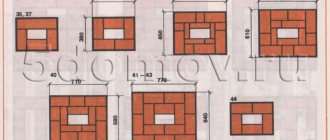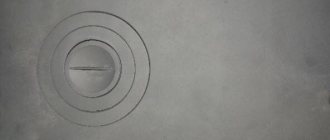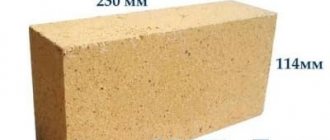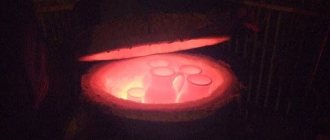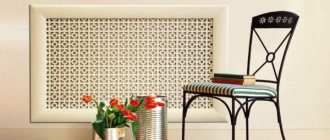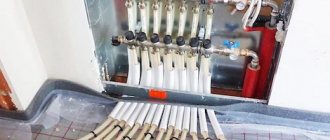The appearance and strength characteristics of ceramic products are formed under the influence of high temperature. For this purpose, a ceramic kiln is used. The devices differ in design, thermal source, temperature limit and other parameters. Craftsmen can either purchase industrial equipment or make a stove themselves.
Figure 1. Kiln for firing ceramics
Article on the topic - types and types of stoves.
Classification of ceramic furnaces
Devices for heat treatment of ceramics are classified according to a number of characteristics. Thanks to the variability of kilns, ceramists have the opportunity to choose a device based on their needs and capabilities.
Types by location of heating elements
There are muffle and chamber furnaces. In the first case, the heating elements are located around a chamber made of fire-resistant material (muffle). In chamber types, the heating sources are located inside the container.
Figure 2. Muffle equipment
*
The heat loss of chamber furnaces is lower since the heat is not dissipated by the refractory. But in some cases, to achieve higher quality products, an intermediary in the form of a muffle is necessary.
Devices in which there is only a chamber space between the ceramics and the heat source are characterized by a higher temperature. Most units of this type are professional - with wider capabilities.
Device
Regardless of whether you are making a ceramic kiln from a barrel or using an industrial version, each design is made from several main parts:
- The outer casing of the unit can be made of stainless steel or an old refrigerator. Its main task is to create a power frame around the internal firebox and oven. Steel structures are not competitors to brick buildings, which will last a long time. To manufacture the steel outer casing we use steel, sheet thickness from 2 mm.
- Inner layer of thermal insulation. To do this, use fireclay brick or other heat-insulating material that can withstand heating temperatures above 2000. The performance of the device and heat loss depend on the heat-insulating qualities of this layer.
- A layer of thermal insulation between the inner layer and the oven body. Use mineral wool, basalt wool, and perlite. It is not recommended to use sheet asbestos. At high temperatures, the material releases substances harmful to humans.
- Chambers for laying clay products and heating elements. For electric furnaces, nichrome spirals or air heating elements are used. These devices are installed in grooves that are selected in fireclay bricks. Nichrome wire is the best option for electric furnaces. Gas burners are installed for gas.
Operating rules
The electric oven may only be plugged into a reinforced socket. You can also run a large cross-section wire directly from the shield. In addition, it would be useful to install a circuit breaker.
Since this device model has exposed wires, you need to be extremely careful with it. Do not touch the coils while the oven is running. To avoid accidents, it is recommended to install a limit switch on the door, which will turn off the unit when the door is opened. If you are not very good at electrical work, seek the help of a specialist who can help make the device as safe as possible, including grounding it.
Principle of operation
Furnaces for firing ceramic products, regardless of the type of fuel, operate according to a certain scheme:
- air-dried clay products are placed in the cavity for placement. We place large items at the bottom and place the rest of the toys or plates like a pyramid;
- The oven door closes tightly and the temperature in the oven gradually increases. First we bring it to 1500-2000;
- after preliminary heating of the parts for 2 hours, the temperature rises to 3500-4000;
- after 2 hours we increase the temperature by another 2000 and so bring the heating to 9000;
- turn off the heating devices or extinguish the flame in the oven and leave the products to cool gradually. The door must always be closed until the finished ceramic is removed.
Uniform and gradual cooling makes ceramics strong and durable. After the entire firing stage, you can begin to apply a layer of glaze or other decorative finishing.
Important! Using an oven for baking polymer clay, we achieve volume of products and give them additional attractiveness. A flower bouquet that has been hardened will look like a real one.
Thermocouple
The thermocouple has been used for measuring the temperature in a furnace for quite some time. At the same time, it has established itself as a reliable measuring device. Essentially, these are two wires consisting of different alloys, which are connected to each other by welding.
When measuring temperature, a current is generated at the ends of the wires, and the higher the oven temperature, the more millivolts we get at the output. Using special devices, you can easily convert millivolts into a temperature indicator.
There are a huge number of types of thermocouples, which consist of different alloys. A type K thermocouple is intended for the muffle furnace. It consists of a chromel-alumel alloy and is designed for temperatures up to 1300 °C. For high temperature environments, it is recommended to use a thick wire thermocouple.
You can measure the temperature inside the furnace with a thermocouple using various devices. We will describe some of them below.
A multimeter is an affordable measuring device; in its design, the function of determining temperature with a K-type thermocouple is immediately thought out. Basically, this type of converter is immediately sold in a set with a multimeter. The only drawback is that the TCA proposed in this version is thin and quickly breaks down at high temperatures.
You can also use type S thermocouples based on platinum-rhodium-platinum alloys. They are more expensive than K-type thermocouple alloys, but withstand high temperatures better as they are rated for 1600 °C and will last longer. According to the standard, such a thermocouple is supplied already in a protective casing.
The thermal converter TPP, like the thermocouple K, is connected to an electronic converting device. Thus, it is possible to easily determine the temperature in the oven and regulate it using a user program.
The TXA converter is another type of meter connected to the controller
It is important here that the length of the wires is sufficient. If the wiring is initially short, then you can use special temperature compensation wires
It is important to understand that the material of the extension wire must consist of the same alloys as the material of the converter itself. But its diameter should be smaller.
By connecting a thermocouple to the controller and connecting them to power, you can immediately find out the temperature in the muffle furnace. To make firing even easier, use the controls and automatically control this process.
On the Tekhnonagrev website you can choose the most suitable thermocouple option and extension wires. If necessary, contact our managers for advice.
When working with a muffle furnace, do not forget about protective equipment. Even when a stove is more than adequately insulated, its outer surface can become hot enough to seriously burn someone if touched with unprotected skin. Therefore, use the following personal protective equipment:
Kiln mitts or gloves: These should be worn when handling any part of the kiln (other than the control panel) while it is firing or cooling. Even after turning off the power, the oven will remain hot for several hours. Do not open or touch it until completely cooled.
Sunglasses. It is recommended to use special safety glasses to observe openings in the oven. They protect your eyes from radiant heat. Regular sunglasses are not suitable for this purpose and can even cause harm, because... not designed for high temperatures. Safety glasses may also allow you to see your cones, if you are using them, more clearly.
Species and types
Such furnaces are divided into several groups.
| Characteristic | Description |
| Type of fuel | Run on gas, electricity or solid fuel |
| Operating temperature of devices | Available:
|
| Device power | In this category, the choice is influenced by the size of future products. The average power of firing furnaces is 5-10 kW. To calculate, use the formula - for 1 liter of volume you will need to provide a power of 0.7-1 kW. |
| Configuration type | Such devices are manufactured:
|
Industrial furnaces should be made only from high-quality fireproof and heat-resistant materials, with a low thermal conductivity value and capable of withstanding being in an aggressive environment for a long period.
Gas kiln for firing ceramics with fireclay bricks - this design is not popular. Fireclay has been replaced with modern materials.
It is important to consider all qualities when choosing an industrial furnace and when developing a homemade design.
Method two. We make a stove without having a metal casing at hand
The manufacturing process in this case is not much different from that described above, but there are definitely some nuances here. Let's start with the fact that the working volume of the design below will be about 13 liters. The spiral, as mentioned above, can warm up to a thousand degrees in just 1.5 hours, while the temperature of the outer walls of the device will not exceed 100 degrees. The algorithm of actions should be as follows.
Step 1. First, using a 4x2 centimeter profile pipe (with a square cross-section), we build a stand for the device. After this, we paint the finished stand with enamel.
Step 2. We attach a sheet of galvanized steel on top of the stand (its thickness should be approximately 0.1 centimeters), using “metal” self-tapping screws.
Step 3. We make the walls from fireclay bricks and a special fireplace composition (everything is the same as in the previous version). After the solution hardens, we make grooves for the spiral.
Step 4. We assemble the bottom from brick separately, and use the same mortar for fastening. Before continuing work, wait until the structure is completely dry. Do not forget to wet each brick immediately before laying.
Step 5. We lay a thermal insulation layer on top of the metal base (we can use the same basalt wool for this). In order to maximize compaction of this layer, it must be moistened before fixing the brick bottom.
Step 6. We continue the traditional laying of the stove, but we try to ensure that all voids and seams are carefully filled.
Step 7. We traditionally make the lid for the chamber from fireclay bricks, but at the same time we fasten them together with a metal tie.
Step 8. Place the spiral in the prepared grooves and insulate the structure from the outside with thermal insulation material. Next, we cover everything with sheets of galvanized steel, which are cut according to the dimensions of the resulting chamber.
As you can see, this requires knowledge not only in the furnace business, but also in the field of electricity. You can see another possible manufacturing method in the video below.
Video - wood burning stove
How to make a Bubafonya stove yourself
Previously, we talked about how to make a Babufonya stove on your own, in addition to this article, we advise you to read this information, see all the details here
How to choose?
In this matter, be sure to pay attention to several factors indicated in the table.
| Characteristic | Short description |
| Price | If you plan to purchase a muffle structure, be sure to remember its high price. We do not recommend looking at cheap, even promotional sales. It is worth understanding what makes up the high price of such devices:
|
| Power | We do not recommend buying a powerful machine with a large compartment for blanks if you plan to produce clay whistles. For such work, it is better to make or buy a small, low-power design. The formula for calculating the required performance of the device is given above. |
| Product loading type | Top loading on furnaces reduces the final cost of the device, but the quality of firing remains at the same level. And it becomes easier to control the firing process. But you will need to lay clay products very carefully. Side loading makes it easier to stack parts and will allow you to place them at the optimal distance, but such a stove is heavy and large in size. The most expensive and productive is the bell furnace. |
Important! The price of ceramic kilns is the main criterion for choosing and identifying a possible fake. Professionals pay 100,000 rubles for such a design; for handicraft production and top loading, the cost will be up to 35,000 rubles.
Model overview
| Model | Characteristics. Dimensions in mm (W, D, H) | Price in rubles |
| Furnace "Bossert Technology PM-1700 p" |
| 48000 |
| "ROSMufel 18/1100/3kW/220W" |
| 105000 |
| Oven "Master 45" |
| Price is negotiable, depends on the level of automation, finishing material of the inner layer |
| "ARIES.11.M.00" |
| 123000 |
| "Master 45 AGNI" |
| From 109000 |
Solid fuel stoves
*
Unlike the previous two, this variation is characterized by artisanal production. The wood-burning clay kiln is the ancestor of modern devices. Even now, when there is no shortage of advanced models, many potters do not abandon traditional designs. For a specialist, working with fire is not just a craft, but also a great pleasure.
Figure 6. Wood-burning kiln for ceramic firing
Typically, such equipment is made of brick. Sometimes an iron barrel plays the role of a kiln. The brick option is preferable for many reasons, including high power, safety, reliability, and long service life.
In any case, a wood stove requires a foundation. The foundation is made no earlier than a day after constructing the hole and thoroughly compacting the bottom.
Brick kilns are usually made with two rows. The outer row of bricks makes work more comfortable - you won’t get burned on it. A chimney is used as a chimney. The wider and higher the latter, the more efficient the removal of waste and the safer the firing.
A wood-fired pottery kiln is not very efficient. Therefore, those who strive not only to maintain traditions, but also to be more productive, choose other options. But for the owner of a private house this is a good solution. Especially when you consider the cost of modern equipment. Although more technologically advanced devices can be made on your own.
Difficulties in manufacturing
Note:
- Safe connection of the cylinder to the burner. Do not use a rubber gas hose near a hot stove - use a metal one.
The gas cylinder must be located at a safe distance and be sure to use a reducer with a check valve.
- Seal all cracks with clay, asbestos or basalt cord.
- The stove is installed away from flammable objects.
- When working, do not touch the oven elements with bare hands.
Attention! Do not allow children onto the playground!
- The outlet for the burnt gases must be of sufficient diameter, otherwise the flame will “choke”; it can be regulated with a piece of insulation.
Where is the best place to install?
It is better not to place the installation in small and enclosed spaces that do not have ventilation (closets or closets). The stove should not be installed in the room where people live, where they sleep, eat, etc. It is better to choose a separate room for it, with an open window. Where you can create a small studio specifically for firing.
Be sure to maintain a distance from the stove and to any object or wall. It should not be less than 30 cm. And according to fire safety rules, the ceramist should not store near objects or materials that can easily ignite
It is also very important to check the material of the walls that surround the stove. It must not be drywall or other flammable material.
The ideal option is tile or concrete walls.
But the floor should not be ignored; it should also consist of a special material. And it should not be a carpet, parquet, or linoleum sheet. If the floor is not made of concrete or another material that is not on the flammable list, then you should not immediately destroy and break everything. In some cases, it is enough to simply lay a sheet of iron directly on the floor surface and carefully install the stove on it. Date: September 25, 2022

